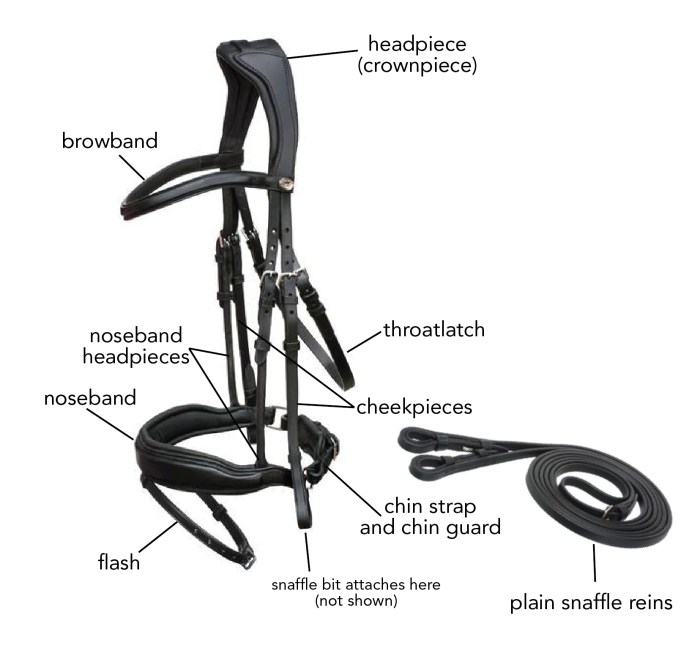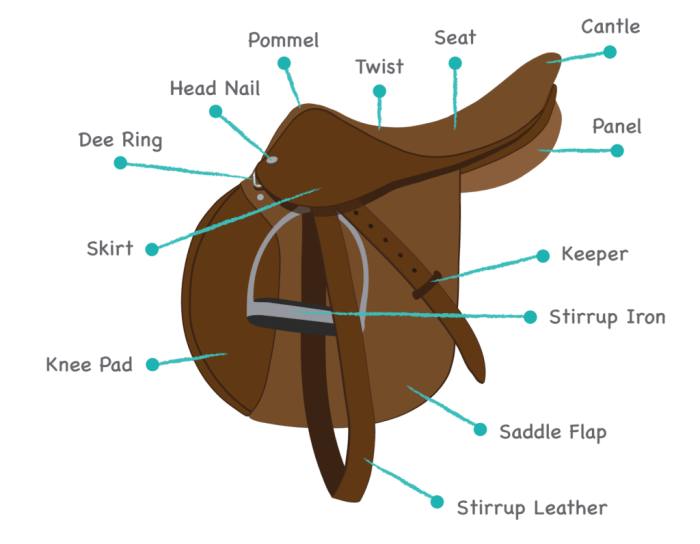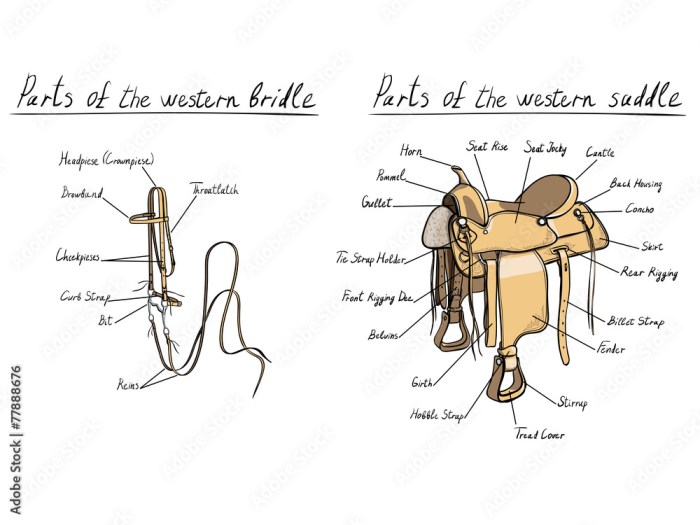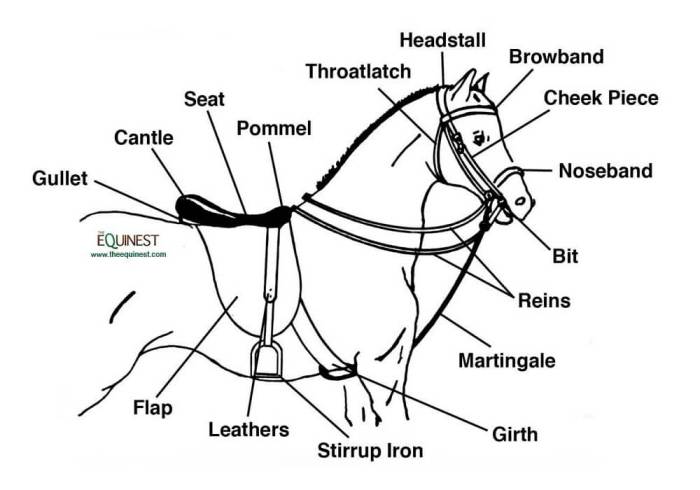Delve into the intricate world of equestrianism as we embark on a journey to unravel the parts of a bridle and saddle. From the headstall that adorns the horse’s head to the saddle that provides comfort and control, each component plays a vital role in the harmonious partnership between horse and rider.
Join us as we explore the intricacies of these essential equestrian tools, uncovering their functions, variations, and the significance of proper fit and handling.
Headstall
The headstall is the part of the bridle that goes around the horse’s head and holds the bit in place. It is typically made of leather or nylon and consists of three main parts: the crownpiece, the browband, and the cheekpieces.
The crownpiece is the part of the headstall that goes over the horse’s poll. It is usually made of a single piece of leather or nylon and is adjustable to fit the horse’s head. The browband is the part of the headstall that goes across the horse’s forehead.
It is usually made of leather or nylon and can be decorated with studs or other embellishments. The cheekpieces are the parts of the headstall that go down the sides of the horse’s face and attach to the bit. They are usually made of leather or nylon and are adjustable to fit the horse’s head.
Types of Headstalls
There are many different types of headstalls available, each designed for a specific purpose. Some of the most common types of headstalls include:
- Snaffle bridle:This is the most common type of headstall and is used for general riding. It has a simple design with a snaffle bit and a leather or nylon headstall.
- Double bridle:This type of headstall is used for more advanced riding and has two bits, a snaffle bit and a curb bit. The curb bit is attached to the headstall with a curb chain, which helps to control the horse’s head and neck.
- Western headstall:This type of headstall is used for Western riding and has a distinctive design with a wide browband and a large bit. The bit is usually a curb bit or a spade bit.
Materials Used in Headstall Construction
Headstalls are typically made of leather or nylon. Leather is a durable and comfortable material that is easy to care for. Nylon is a lightweight and inexpensive material that is also durable and easy to care for.
In addition to leather and nylon, headstalls can also be made of other materials, such as rubber, biothane, and webbing. Rubber headstalls are waterproof and easy to clean, making them a good choice for horses that are ridden in wet or muddy conditions.
Biothane headstalls are made of a durable synthetic material that is waterproof, easy to clean, and does not stretch or rot. Webbing headstalls are made of a strong, lightweight material that is breathable and comfortable for the horse.
Bit

The bit is a crucial component of the bridle, acting as the primary means of communication between the rider and the horse. It is inserted into the horse’s mouth and exerts pressure on specific areas, guiding and controlling the horse’s movements.The
choice of bit depends on the horse’s training level, temperament, and the desired level of control. Different types of bits have varying effects on the horse’s mouth, influencing its sensitivity and responsiveness.
Types of Bits
Bits come in various designs, each serving a specific purpose:-
- Snaffle Bit:A common bit with a jointed mouthpiece that applies even pressure on both sides of the horse’s mouth, encouraging flexion and steering.
- Curb Bit:A more advanced bit that includes a curb chain, which increases pressure on the horse’s poll and chin, providing greater control and leverage.
- Kimberwick Bit:A hybrid bit that combines features of both snaffle and curb bits, offering a balance of control and comfort.
Importance of Proper Bit Fitting
Proper bit fitting is essential for the horse’s comfort and performance. An ill-fitting bit can cause discomfort, pain, and even injury. Factors to consider include the size and shape of the horse’s mouth, the type of riding discipline, and the horse’s individual preferences.A
qualified professional, such as an equine dentist or a bit fitter, can help determine the most suitable bit for a particular horse, ensuring a harmonious relationship between rider and mount.
If you’re curious about the parts of a bridle and saddle, you might also be interested in the Fahrenheit 451 Part One Test . After all, understanding the components of these equestrian tools is just as fascinating as delving into the intricacies of classic literature.
So, whether you’re a horse enthusiast or a book lover, there’s something for everyone in exploring both worlds.
Reins: Parts Of A Bridle And Saddle

Reins are essential components of a bridle that provide the rider with a means to guide and control the horse. They are attached to the bit in the horse’s mouth and extend through the rider’s hands, allowing them to communicate their intentions to the animal.
Types of Reins
There are various types of reins designed for different riding disciplines and horse training methods. Some common types include:
- Snaffle Reins:Made of leather or synthetic materials, these reins are used with a snaffle bit and are commonly found in English riding.
- Curb Reins:Thicker and heavier than snaffle reins, curb reins are used with a curb bit and provide more leverage for the rider.
- Mecate Reins:A single, long rein made of braided leather or nylon, mecate reins are traditionally used in Western riding and allow for quick release if necessary.
- Rommel Reins:Similar to mecate reins, Rommel reins are made of leather or biothane and feature a built-in bit, making them convenient for training and groundwork.
Effective Rein Handling
Proper rein handling is crucial for effective communication with the horse. Here are some tips for effective rein use:
- Maintain a Soft Contact:Keep a gentle and consistent contact with the horse’s mouth, allowing for slight movements without pulling or jerking.
- Use Light Cues:Apply subtle pressure to the reins to guide the horse rather than relying on force.
- Coordinate with Body Language:Combine rein cues with body language, such as leg and seat aids, to reinforce commands.
- Avoid Over-Reining:Excessive pulling or jerking on the reins can confuse and frustrate the horse, leading to resistance.
Saddle
The saddle is a crucial piece of equestrian equipment that serves as a comfortable and secure seat for the rider. It also provides support and balance to the rider, enabling them to control the horse effectively.
The saddle consists of several key parts, each with a specific function:
Saddle Parts
- Tree:The rigid frame that forms the foundation of the saddle. It provides structural support and distributes the rider’s weight evenly across the horse’s back.
- Panel:A padded area beneath the seat that rests on the horse’s back. It absorbs shock and provides cushioning for both the rider and the horse.
- Girth:A strap that wraps around the horse’s belly, securing the saddle in place.
- Seat:The part of the saddle where the rider sits. It should be designed to provide a comfortable and stable position.
- Cantle:The rear part of the saddle that prevents the rider from sliding backwards.
- Pommel:The front part of the saddle that keeps the rider from sliding forward.
- Stirrups:Metal loops that hang from the saddle and support the rider’s feet. They provide stability and allow the rider to influence the horse’s movement.
Saddle Fit
Proper saddle fit is essential for both the comfort and safety of the rider and horse. A saddle that fits poorly can cause pain, discomfort, and even injury to the horse. It can also make riding difficult and less enjoyable for the rider.
Factors to consider when fitting a saddle include the horse’s breed, size, and back shape, as well as the rider’s height and weight. A qualified professional should always be consulted to ensure a proper fit.
Girth

The girth is an essential part of the saddle, as it secures the saddle in place on the horse’s back. It is a wide strap that wraps around the horse’s belly and is tightened to keep the saddle from slipping forward or backward.
There are different types of girths available, each with its own advantages and disadvantages. Some of the most common types of girths include:
Web Girths, Parts of a bridle and saddle
- Made of durable webbing material
- Lightweight and flexible
- Easy to clean and maintain
- Less expensive than other types of girths
Leather Girths
- Made of high-quality leather
- Durable and strong
- Comfortable for the horse
- More expensive than web girths
Neoprene Girths
- Made of a synthetic material called neoprene
- Soft and comfortable
- Conforms to the horse’s body
- May not be as durable as other types of girths
Girth Tightening
It is important to tighten the girth properly to ensure that the saddle is secure without being too tight. The girth should be snug enough to keep the saddle from moving, but not so tight that it restricts the horse’s breathing or movement.
To tighten the girth, follow these steps:
- Place the girth around the horse’s belly.
- Pull the girth up through the saddle’s girth straps.
- Tighten the girth by pulling on the buckles.
- Check the girth’s tightness by placing your hand between the girth and the horse’s belly. The girth should be snug, but you should be able to fit your hand between the girth and the horse’s belly.
Stirrups
Stirrups are essential components of a saddle that provide support and stability to the rider’s feet while horseback riding. They allow the rider to maintain balance and control over the horse’s movements.
Types of Stirrups
- English Stirrups:Designed for English saddles, these stirrups are typically lightweight and have a narrow, arched shape. They allow for a more secure grip and precise leg positioning.
- Western Stirrups:Wider and heavier than English stirrups, Western stirrups provide a stable platform for the rider’s feet. They often have a leather-covered tread for added comfort.
- Safety Stirrups:These stirrups feature a release mechanism that allows the rider’s foot to slip out easily in case of a fall, preventing the rider from being dragged.
- Balanced Stirrups:Designed to improve balance and leg position, balanced stirrups have a weighted base that keeps the stirrup in a vertical position, reducing fatigue and improving rider comfort.
Proper Stirrup Length Adjustment
Proper stirrup length is crucial for comfort and safety. The stirrups should be long enough to allow the rider’s leg to hang comfortably, with a slight bend in the knee. When the rider is sitting in the saddle, the stirrup should be approximately at the level of the rider’s ankle bone.
To adjust the stirrup length:
- Mount the horse and sit in the saddle.
- Adjust the stirrup length so that the stirrup is at the level of the rider’s ankle bone.
- Ride around for a few minutes to ensure the length is comfortable and allows for proper leg movement.
Saddle Pad

The saddle pad, also known as a numnah, is an essential component of the saddle and plays a crucial role in ensuring the horse’s comfort and protection. It serves as a cushioning layer between the saddle and the horse’s back, distributing the rider’s weight evenly and preventing pressure points.
Types of Saddle Pads
Saddle pads come in various types, each designed for specific purposes:
- General Purpose:These pads are suitable for most riding disciplines and provide basic cushioning and protection.
- Dressage:Dressage pads are typically thicker and offer additional support for the horse’s back, promoting correct posture and comfort.
- Jumping:Jumping pads are designed to provide shock absorption during jumps, reducing impact on the horse’s back and legs.
- Western:Western saddle pads are larger and feature a contoured design to accommodate the unique shape of Western saddles.
- Corrective:Corrective pads are designed to address specific back issues or imbalances, such as saddle fit problems or uneven muscle development.
Importance of Proper Saddle Pad Fit
Proper saddle pad fit is essential for the horse’s comfort and performance. An ill-fitting pad can cause pressure points, discomfort, and even back problems. The pad should fit snugly against the horse’s back without shifting or bunching up.
Key Questions Answered
What is the purpose of a headstall?
A headstall is the foundation of a bridle, securing the bit in the horse’s mouth and providing attachment points for the reins.
How do I choose the right bit for my horse?
Bit selection depends on the horse’s training level, sensitivity, and riding discipline. Consult with an experienced equestrian or veterinarian for guidance.
What are the different types of saddles?
Saddles vary in design to accommodate different riding styles and horse breeds. Common types include English saddles for jumping and dressage, Western saddles for trail riding and roping, and endurance saddles for long-distance riding.